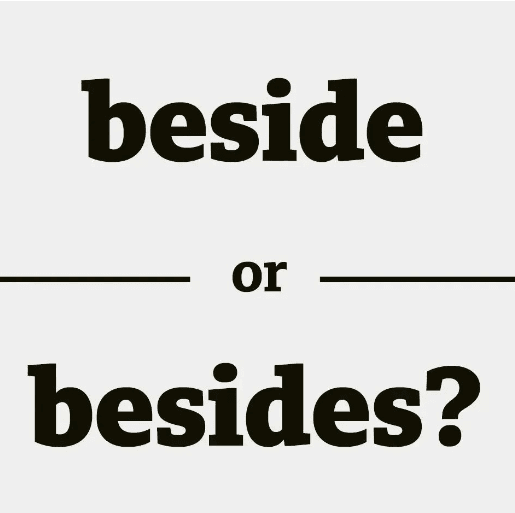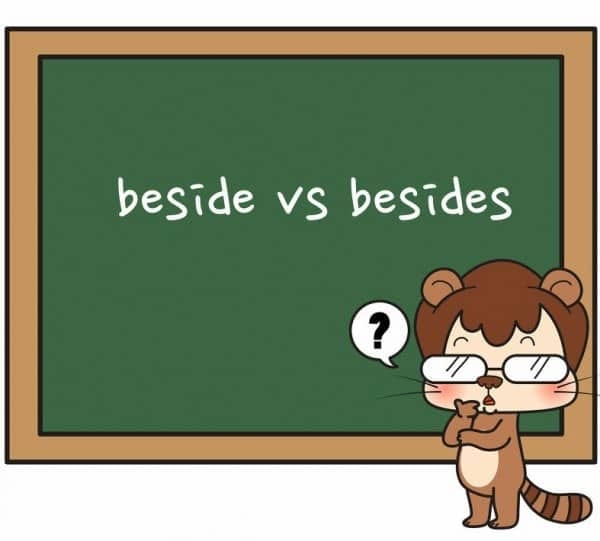Choosing the Right Word: Beside vs Besides Demystified
Contents
- What are Prepositions?
- Understanding 'Beside'
- Grasping 'Besides'
- Beside Vs Besides – Spotting the Key Differences
- Common Errors Indians Make with ‘Beside’ and ‘Besides’
- Enhancing Your Fluency – Practice Exercises
- Activity 1: Fill-in-the-blanks exercises using 'beside' and 'besides.'
- Activity 2: Sentence formation tasks using both words.
- How Clapingo Can Help You Overcome These Challenges
- Final Thoughts
- Frequently Asked Questions (FAQs)

Picture this. You're in a business meeting with foreign clients, and you say, "I have other responsibilities besides this project," but the confusion on their faces tells you that something went wrong. You'd meant to say 'beside' instead of 'besides'. It's a seemingly insignificant error, yet it has left an awkward air hanging in the room.
Terms like 'beside' and 'besides', which sound almost identical, can create tricky situations when misused.
By the end of this blog post, you'll gain a solid understanding of how to distinguish between 'beside' and 'besides', along with the correct usage of each term. We'll provide plenty of beside vs besides examples, unpacking their meanings and contexts to help you navigate these confusing waters. We'll also offer resources like beside vs besides worksheets so that you can practice until these terms become second nature to you.
Let's dive in!
What are Prepositions?
Prepositions are your best friends when it comes to expressing relations in English, be it direction, time, or manner.
Prepositions are incredibly significant in English conversations, often serving as links between words and shaping the overall meaning of a sentence. Here are the 10 most common prepositions in English:
of
in
to
for
with
on
at
by
about
as
Imagine telling someone, "The book is on the table," versus saying, "The book is under the table." The prepositions 'on' and 'under' entirely change the location of the book and subsequently, the overall meaning of your statement.
Mastering preposition usage can dramatically improve your communication skills, enabling you to converse more fluently and confidently. Check out this insightful Clapingo post on the prepositions to and for.
Understanding 'Beside'
The term 'Beside' is a preposition in English which typically conveys the meaning of 'next to' or 'at the side of'. It is used when you want to indicate that something or someone is at the side of another object or individual.
Now, let's look at some grammar rules for using 'Beside':
'Beside' cannot be used with words expressing motion. It can only reference stationary objects.
Keep in mind it never conveys meanings like ‘apart from’ or ‘except for’.
Let's note these correct and incorrect usages in a comparison table:
Correct Usage | Incorrect Usage |
She lives beside a small lake. | I'm going beside Mumbai next week. |
The dog was sitting quietly beside the chair. | There was no one at the party beside me. |
As you see, knowing when to use 'beside' correctly can make your English communication more accurate and effective.
Grasping 'Besides'
Unlike 'beside', 'besides' is a bit more versatile in its uses and meanings. It primarily means 'in addition to' or 'apart from', and is generally meant to expand upon something already stated.
For instance, if you're talking about your favorite subjects at school, you might say, "Besides Mathematics, I also enjoy History." Here, 'besides' introduces an additional subject that you like.
Here are some basic grammar rules for using ‘Besides’:
Used as a preposition when referring to something additional: "Besides cricket, he also likes football."
Used as an adverb when implying furthermore or moreover: "I did not want to go to the party. Besides, I was not even invited."
Here's a comparison table contrasting right vs wrong applications of 'besides':
Correct Usage | Incorrect Usage |
Besides being a singer, she is also an excellent dancer. | She is besides a singer an excellent dancer. |
I can't go out tonight; besides, I have too much homework. | I can't go out tonight besides I have too much homework. |
Beside Vs Besides – Spotting the Key Differences

Let's understand the key beside vs besides differences:
Role in Speech: 'Beside' is a preposition, meaning next to or at the side of. 'Besides' can be a preposition, meaning apart from, or an adverb, meaning also or additionally.
Usage: 'Beside' refers to physical proximity, while 'Besides' indicates addition or exception.
Sentence Position: 'Beside' commonly appears in the middle of a sentence. Conversely, 'Besides' can appear anywhere.
Now, let's illustrate this with a dialogue snippet:
A: "Is anyone sitting beside you?"
B: "No, you can sit here. Besides, I could use some company."
For more on similar confusing English terms, explore our blog list that explores common language challenges faced by Indian learners.
Common Errors Indians Make with ‘Beside’ and ‘Besides’
Here are three common mistakes people make when it comes to the usage of beside vs besides:
Using 'besides' when 'beside' is appropriate: For example, saying "The pen is besides the notebook" instead of "The pen is beside the notebook".
Assuming both words can be used interchangeably: While both these words seem similar, their usage differs significantly in sentences.
These errors usually stem from confusion about the exact meanings and usage of these terms. Here are a couple of simple language tips to avoid these errors:
Whenever you mean to convey proximity or location, use 'beside'.
When you need to express ‘in addition to’ or ‘apart from’, use 'besides'.
Enhancing Your Fluency – Practice Exercises
Let's dive into some exercises that can give you hands-on experience with 'beside' and 'besides.'
Activity 1: Fill-in-the-blanks exercises using 'beside' and 'besides.'
Consider these sentences and fill each blank with either 'beside' or 'besides', based on what you've learned about their usage.
I sat ____ my best friend at the movie.
____ going to football matches, he also enjoys playing chess.
Activity 2: Sentence formation tasks using both words.
Formulate your own sentences employing 'Beside' and 'Besides'. Here are two sample answers for inspiration:
Beside: The pencil is beside the notebook on my desk.
Besides: Besides being an accomplished writer, she is also a skilled painter.
__________________________________________________________________
__________________________________________________________________
__________________________________________________________________
Consistent engagement with such exercises will help reinforce your understanding of "beside" vs "besides," their meanings, usage, and differences effectively.
How Clapingo Can Help You Overcome These Challenges
At Clapingo, we strive to simplify your English learning journey through one-on-one classes with native English speakers. Our teaching approach is tailored to your unique learning pace and style, ensuring you grasp the subtle distinctions between tricky words like 'beside' and 'besides' or 'It's' vs 'Its'. Our tutors are adept at breaking down complex concepts into digestible parts.
So whether it's grasping beside vs besides meaning, or gaining fluency in spoken English overall, Clapingo is here to guide you every step of the way towards your language mastery journey.
Final Thoughts
The main takeaways from our discourse on 'beside vs besides' are:
'Beside' means next to or at the side of something.
'Besides' can mean either in addition to something or apart from something.
Practising these meanings and using them in context will help you understand the usage of beside vs besides.
To facilitate your learning journey further, consider joining Clapingo's personalized coaching sessions. Book a quick demo now.
Frequently Asked Questions (FAQs)
1. Can I use 'beside' and 'besides' interchangeably?
No, 'beside' and 'besides' have different meanings and are used in different contexts. 'Beside' refers to physical proximity, while 'besides' indicates an addition or exception. Using these words interchangeably can change the meaning of your sentence.
2. What is the difference between beside and besides?
The main difference lies in their usage. 'Beside', a preposition, typically means next to or adjacent to. For instance, "The pen is beside the notebook." On the other hand, 'besides' can be a preposition or an adverb implying moreover or apart from. Example: "Besides tea, I also like coffee".
3. How do I remember when to use ‘beside’ and ‘besides’?
Remember that ‘beside’ usually refers to a physical location while ‘besides’ usually introduces additional information or exceptions. Associating each word with its function should help you use them correctly.
Comments
Your comment has been submitted